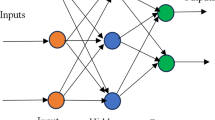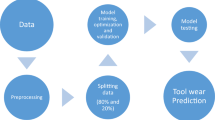Abstract
The present paper highlights the prediction of tool wear through artificial neural network (ANN) and regression methodology during machining of AISI 4340 steel. Abrasive nature of wear dominates more during experimental investigation. Flank wear model through quadratic regression yields high correlation coefficient (R2 = 0.961 close to unity) which indicates the goodness of fit of the model. Contour plots determine optimal parameters of low levels such as 0.4 mm depth of cut of 0.04 mm/rev feed and 50 m/min cutting speed to obtain minimal flank wear in machining. The average percentage of error between experimental to ANN is found to be only 2.02 whereas this error is maximum in regression model (18.94). Hence, model developed by ANN is found to be effective during machining study for flank wear prediction.
Access this chapter
Tax calculation will be finalised at checkout
Purchases are for personal use only
Similar content being viewed by others
References
Asiltürk I (2012) Predicting surface roughness of hardened AISI 1040 based on cutting parameters using neural networks and multiple regression. Int J Adv Manuf Technol 63(1–4):249–257
Kpina B, Nwosu HU (2018) Modelling of cutting parameters in turning operation to enhance surface quality. Int. J Rec Eng Sci 10:17–23
Prakash DB, Krishnaiah DG, Shankar NVS (2016) Optimization of process parameters using Taguchi techniques when turning AISI 1040 steel with coated tools. Int J Mech Eng Technol 7(6):114–122
Basheer AC, Dabade UA, Joshi SS, Bhanuprasad VV, Gadre VM (2008) Modeling of surface roughness in precision machining of metal matrix composites using ANN. J Mater Process Technol 197(1–3):439–444
Davim JP, Gaitonde VN, Karnik SR (2008) Investigations into the effect of cutting conditions on surface roughness in turning of free machining steel by ANN models. J Mater Process Technol 205(1–3):16–23
Escamilla I, Torres L, Perez P, Zambrano P (2008) A comparison between back propagation and the maximum sensibility neural network to surface roughness prediction in machining of Titanium ( Ti 6Al 4V) alloy. In: Lecture Notes in Computer Science Mexican International Conference on Artificial Intelligence. Springer, Berlin, Heidelberg, pp 1009–1019
Ramesh S, Karunamoorthy L, Palanikumar K (2008) Fuzzy modeling and analysis of machining parameters in machining Titanium alloy. Mater Manuf Process 23(4):439–447
Karayel D (2009) Prediction and control of surface roughness in CNC lathe using artificial neural network. J Mater Process Technol 209(7):3125–3137
Asiltürk I, Çunkaş M (2011) Modeling and prediction of surface roughness in turning operations using artificial neural network and multiple regression method. Expert Syst Appl 38(5):5826–5832
Risbood KA, Dixit US, Sahasrabudhe AD (2003) Prediction of surface roughness and dimensional deviation by measuring cutting forces and vibrations in turning process. J Mater Process Technol 132(1–3):203–214
Özel T, Karpat Y (2005) Predictive modeling of surface roughness and tool wear in hard turning using regression and neural networks. Int J Mach Tool Manuf 45(4–5):467–479
Tsourveloudis NC (2010) Predictive modeling of the Ti6Al4V alloy surface roughness. J Intell Robot Syst 60(3–4):513–530
Kumar R, Sahoo AK, Das RK, Panda A, Mishra PC (2018) Modelling of flank wear, surface roughness and cutting temperature in sustainable hard turning of AISI D2 steel. Proc Manufact 20:406–413
Sahu NK, Andhare AB, Andhale S, Abraham RR (2018) Prediction of surface roughness in turning of Ti-6Al-4V using cutting parameters, forces and tool vibration. In: IOP Conference Series, Mater Sci Eng 346(1): 1–12
Author information
Authors and Affiliations
Editor information
Editors and Affiliations
Rights and permissions
Copyright information
© 2022 The Author(s), under exclusive license to Springer Nature Singapore Pte Ltd.
About this paper
Cite this paper
Sahoo, A.K., Panda, A., Kumar, R. (2022). On Tool Wear Prediction Using Artificial Neural Network and Regression Methodology During Machining. In: Pattnaik, P.K., Sain, M., Al-Absi, A.A. (eds) Proceedings of 2nd International Conference on Smart Computing and Cyber Security. SMARTCYBER 2021. Lecture Notes in Networks and Systems, vol 395. Springer, Singapore. https://doi.org/10.1007/978-981-16-9480-6_30
Download citation
DOI: https://doi.org/10.1007/978-981-16-9480-6_30
Published:
Publisher Name: Springer, Singapore
Print ISBN: 978-981-16-9479-0
Online ISBN: 978-981-16-9480-6
eBook Packages: Intelligent Technologies and RoboticsIntelligent Technologies and Robotics (R0)




